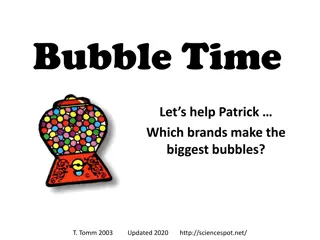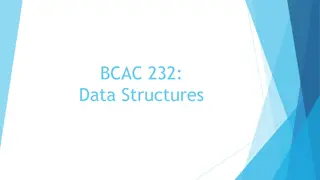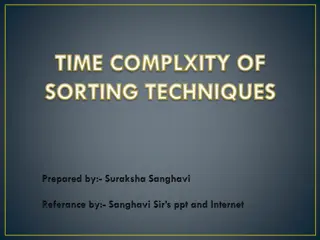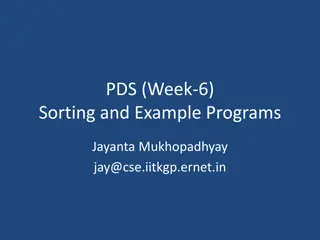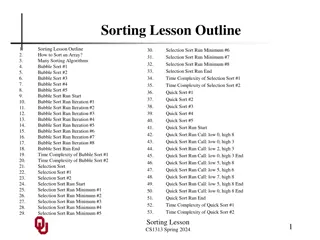Introduction to Bubble Sort and Selection Sort
Learn the basics of bubble sort and selection sort algorithms. Dive into the step-by-step process of sorting elements efficiently. Explore animations and examples to grasp the concepts effectively.
Download Presentation

Please find below an Image/Link to download the presentation.
The content on the website is provided AS IS for your information and personal use only. It may not be sold, licensed, or shared on other websites without obtaining consent from the author.If you encounter any issues during the download, it is possible that the publisher has removed the file from their server.
You are allowed to download the files provided on this website for personal or commercial use, subject to the condition that they are used lawfully. All files are the property of their respective owners.
The content on the website is provided AS IS for your information and personal use only. It may not be sold, licensed, or shared on other websites without obtaining consent from the author.
E N D
Presentation Transcript
COMP 110-001 Introduction to Sorting Yi Hong June 12, 2015
Today Introduction to Sorting Bubble sort Selection sort Merge sort You should understand the idea behind bubble sort & selection sort You should be able to understand understand the code given in slides (and know how to use the code in similar know how to use the code in similar problems by making slight modifications problems by making slight modifications).
Bubble Sort (or Sinking Sort) Basic idea (Wikipedia) Start from the beginning of the list Compare every adjacent pair, swap their positions if they are not in the right order After each iteration, one less element (the last one) is needed to be compared until there is no more elements left to be compared Animation from Wikipedia:
Bubble Sort Step Step- -by First First Pass: Pass: ( 5 5 1 1 4 2 8 ) ( 1 1 5 5 4 2 8 ), Compares the first two elements, and swaps because 5 > 1. ( 1 5 5 4 4 2 8 ) ( 1 4 4 5 5 2 8 ), Swaps because 5 > 4 ( 1 4 5 5 2 2 8 ) ( 1 4 2 2 5 5 8 ), Swaps because 5 > 2 ( 1 4 2 5 5 8 8 ) ( 1 4 2 5 5 8 8 ), In order (8 > 5), no need to swap Second Pass: Second Pass: ( 1 1 4 4 2 5 8 ) ( 1 1 4 4 2 5 8 ) ( 1 4 4 2 2 5 8 ) ( 1 2 2 4 4 5 8 ), Swap since 4 > 2 ( 1 2 4 4 5 5 8 ) ( 1 2 4 4 5 5 8 ) ( 1 2 4 5 5 8 8 ) ( 1 2 4 5 5 8 8 ) Now, the array is already sorted, but our algorithm does not know if it is completed. The algorithm needs one whole whole pass without any any swap to know it is sorted. Third Third Pass: Pass: ( 1 1 2 2 4 5 8 ) ( 1 1 2 2 4 5 8 ) No swap ( 1 2 2 4 4 5 8 ) ( 1 2 2 4 4 5 8 ) No swap ( 1 2 4 4 5 5 8 ) ( 1 2 4 4 5 5 8 ) No swap ( 1 2 4 5 5 8 8 ) ( 1 2 4 5 5 8 8 ) No swap, done. by- -step example of step example of "5 1 4 2 8
Selection Sort Given an array of length n, each time select the smallest one among the rest elements: Search elements 0 through n-1 and select the smallest Swap it with the element at location 0 Search elements 1 through n-1 and select the smallest Swap it with the element at location 1 Search elements 2 through n-1 and select the smallest Swap it with the element at location 2 Search elements 3 through n-1 and select the smallest Swap it with the element at location 3 Continue until there s no element left Animation from Wikipedia:
An Example of Selection Sort Step by step example: 7 2 8 5 Iteration 1: found 2, swap it with 7 Iteration 2: found 4, swap it with 7 Iteration 3: found 5, swap it with 8 Iteration 4: found 7, swap it with 7 The selection sort might swap an array element with itself--this is harmless, and not worth checking
Merge Sort Bubble Sort and Selection Sort: Intuitive and easy to implement Help build basic abstract sorting concepts Requires ~n^2 * c ~n^2 * c operations in worst case n : number of items to sort c : some constant factor Not commonly used in practice Two commonly used sorting algorithms in practice: Quick Sort & Merge Sort
Merge Sort Strategy: Strategy: Recursively split the list in half and Recursively split the list in half and merge the merge the two returned two returned segments Java s built-in sort function is a variant of merge sort: Collections.sort Collections.sort( .. ); Quick sort: Quick sort: Arrays.sort Arrays.sort(..); ~ n*log(n) * c n*log(n) * c operations in worst case Check the difference between n*log(n) n*log(n) and n^2 n^2 when n is large segments ( .. ); (..);
Merge Sort 3024 7 1214 4 20 21 333810 55 9 23 28 16 Split the array into two or more parts 3024 7 1214 4 20 21 3338 10 55 9 23 28 16 Sort each part individually 4 7 12 14202124 30 9 10 16 23283338 55 Merge 4 7 9 101214 16 20 2123 24 283033 38 55
Merge Sort Animation from Wikipedia:
Merge Sort Not easy to implement Merge sort correctly No Java code here (beyond the level of COMP110) Just understand the high-level idea
Next Class Review of final exam






